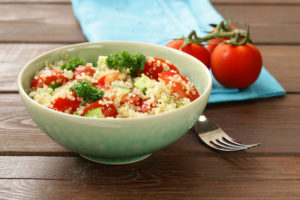Quinoa Nutrition Facts: Notable for Protein, Fiber, Iron, Magnesium, and More
Quinoa is a worthy source of iron, phosphorous, and other nutrients, and it’s free of saturated fat and cholesterol. Plus, quinoa nutrition facts show that it benefits heart and digestive health—and that’s not all…
Quinoa (pronounced KEEN-wah) has garnered a great deal of attention from diet and nutrition experts in recent years due to its nutrition profile. Quinoa is actually a seed, although it’s commonly referred to as a grain for obvious reasons (quinoa seeds are grain-like in size, texture, and consistency when cooked). Although the seeds are small, quinoa nutrition facts are impressive.
One cup of cooked quinoa provides about 8 grams of protein—equal to the protein found in about an ounce of meat or cheese—but quinoa contains no saturated fat, which is found in many animal-sourced foods. In addition, quinoa is atypical of plant foods in that the protein in quinoa is “complete”; this means it contains all of the essential amino acids the body needs in the correct proportions. There are only a few plant-based foods that are sources of complete proteins.
That same cup of cooked quinoa also contains five grams of fiber. Fiber adds bulk to your meals and helps you feel fuller faster and longer, which may be helpful when you’re trying to control your weight. In addition, fiber plays a role in digestive health and can help prevent constipation. It also may be beneficial in preventing heart disease and certain cancers.
Noteworthy Quinoa Nutrition Facts
So exactly what’s in this mineral goldmine? Besides the health benefits noted above, quinoa nutrition facts include an array of minerals that are valuable to our bodies.
One cup of cooked quinoa contains almost 3 milligrams of iron, which is about 50 percent more than what you’ll get from 3 ounces of red meat. Iron helps transport oxygen from your lungs throughout your body and also helps your muscles store and use oxygen. To help boost the iron that your body is able to absorb, eat your quinoa with vitamin C-rich foods such as red or orange peppers or citrus fruits.

Quinoa, cucumber, and tomato salad—one of countless creative ways to work quinoa onto your menu. [Photo: © Olga Kriger | Dreamstime.com]
Other nutrients found in quinoa include potassium, zinc, copper, manganese, and folate.
If you’re a calorie counter, you should know that cooked quinoa comes in at a reasonable 220 calories per cup, which is about the same as a cup of cooked pasta or white rice.
Quinoa: Versatility in Your Meals
Besides all those quinoa nutrition facts, the seed is versatile within any menu. Incorporate it into your diet in a variety of ways.
- For breakfast, try quinoa as a hot cereal, much like oatmeal, and top with blueberries or strawberries. Or, you can stir in dried fruit, such as pineapple, apricots, cranberries, or raisins, nuts, and a sprinkle of cinnamon or other favorite spices.
- For a healthy, delicious lunch, combine cooked quinoa with diced cucumbers, bell peppers, and tomatoes, chickpeas, crumbled feta cheese, and a drizzle of olive oil and vinegar. You also can add high-protein foods, such as grilled chicken or shrimp, to your quinoa salad.
- Quinoa can easily be included in a healthy dinner; just serve quinoa instead of pasta, rice, or potatoes. If you don’t care for plain quinoa, stir in cooked onions, peas, and/or carrots and season with a dash of garlic powder and some basil or oregano. For a Mexican-style side dish, add green chilies, cumin, chili powder, and a dash of cayenne or flaked red peppers.
A final bonus regarding quinoa’s nutrition facts: It’s gluten-free, which makes it suitable for people who must avoid gluten because of celiac disease or gluten insensitivity.
This article was originally published in 2018. It is regularly updated.


 Ask the EN Experts March 2025
Ask the EN Experts March 2025  Vegan Diet Better Than Omnivore Diet for Cardiovascular Health
Vegan Diet Better Than Omnivore Diet for Cardiovascular Health 
Quinoa nutrition facts make it a must-add to your menu. Above is a bowl of quinoa seeds; blew: quinoa as the basis of a salad featuring tomatoes and cucumbers.
© Tashka2000 | Dreamstime.com